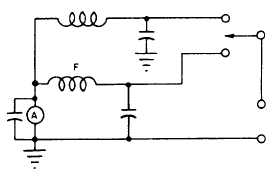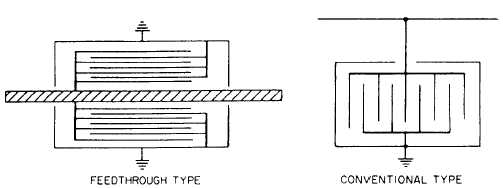Figure 10-4.-Internal construction of feedthrough and conventional capacitor.
constructions of feedthrough
capacitors are shown in figure
differences in the two types.
Selection of Capacitors
Capacitors used for filtering
and conventional
10-4. Notice the
circuits in aircraft
should be selected for characteristics such as physical
size, high temperature and humidity tolerances, and
physical ruggedness. The capacitors should have an
adequate voltage rating (at least twice that of the
circuit to be filtered), and should be installed with
minimum lead length.
Application of Capacitive Filters
Every circuit carrying an unintentionally varying
voltage or current capable of causing radio
interference should be bypassed to ground by suitable
capacitors. When the nature of the variations are such
that interference is caused at both high and low
frequencies, a capacitor should be chosen and
installed to provide an adequate insertion loss at the
lowest frequency where interference exists. When
the overall capacitance required at low frequency
provides inadequate insertion loss at high frequencies,
it should be bridged in the shortest and most direct
manner possible by a second capacitor.
A capacitive filter should be installed as near as
possible to the actual source of interference. Lead
length should be held to an absolute minimum for two
reasons.
First, the lead to the capacitor carries
interference that must not be allowed to radiate.
Second, the lead has inductance that tends to lower
the maximum frequency for which the capacitor is an
effective bypass.
To the extent possible, a filter capacitor should be
installed to make use of any element of the filtered
circuit that provides a better filtering action. Figures
10-5, 10-6, and 10-7 illustrate proper use of filter
capacitors.
Capacitive Filtering in an AC Circuit
The radio interference generated in slip ring ac
motors and generators is a transient caused by
sliding contacts plus high-frequency energy from
other internal sources. For this reason, filtering
should be aimed at reducing high-frequency and
very-high-frequency noise components with the use
of low-capacitance, high-grade capacitors. Wherever
possible, feedthrough capacitors should be used.
Capacitances should be chosen low enough in value
to represent a high impedance at the power frequency
and to avoid resonance with the internal inductances
of the filtered unit. Voltage ratings should be at least
twice the peak voltage across the capacitors.
In a four-wire electrical system, the neutral lead
carries all three phases; a large quantity of the third
harmonic of the power frequency is present. This
Figure 10-5.-Capacitive filtering of a reversible dc series
motor.
10-10




